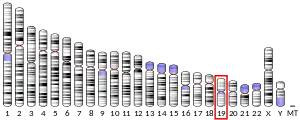EEF2
Eukaryotic elongation factor 2 is a protein that in humans is encoded by the EEF2 gene. It is the archaeal and eukaryotic counterpart of bacterial EF-G.[5][6][7][8]
This gene encodes a member of the GTP-binding translation elongation factor family. This protein is an essential factor for protein synthesis. It promotes the GTP-dependent translocation of the ribosome. This protein is completely inactivated by EF-2 kinase phosphorylation.[7]
aEF2/eEF2 found in most archaea and eukaryotes, including humans, contains a post transcriptionally modified histidine diphthamide.[8] It is the target of diphtheria toxin (from Corynebacterium diphtheriae), and exotoxin A (from Pseudomonas aeruginosa).[9] The inactivation of EF-2 by toxins inhibits protein production in the host, causing symptoms due to loss of function in affected cells.
References
- GRCh38: Ensembl release 89: ENSG00000167658 - Ensembl, May 2017
- GRCm38: Ensembl release 89: ENSMUSG00000034994 - Ensembl, May 2017
- "Human PubMed Reference:". National Center for Biotechnology Information, U.S. National Library of Medicine.
- "Mouse PubMed Reference:". National Center for Biotechnology Information, U.S. National Library of Medicine.
- Rapp G, Klaudiny J, Hagendorff G, Luck MR, Scheit KH (October 1989). "Complete sequence of the coding region of human elongation factor 2 (EF-2) by enzymatic amplification of cDNA from human ovarian granulosa cells". Biological Chemistry Hoppe-Seyler. 370 (10): 1071–5. doi:10.1515/bchm3.1989.370.2.1071. PMID 2610926.
- Kaneda Y, Yoshida MC, Kohno K, Uchida T, Okada Y (May 1984). "Chromosomal assignment of the gene for human elongation factor 2". Proceedings of the National Academy of Sciences of the United States of America. 81 (10): 3158–62. Bibcode:1984PNAS...81.3158K. doi:10.1073/pnas.81.10.3158. PMC 345240. PMID 6427766.
- "Entrez Gene: EEF2 eukaryotic translation elongation factor 2".
- Narrowe AB, Spang A, Stairs CW, Caceres EF, Baker BJ, Miller CS, Ettema TJ (September 2018). "Complex Evolutionary History of Translation Elongation Factor 2 and Diphthamide Biosynthesis in Archaea and Parabasalids". Genome Biology and Evolution. 10 (9): 2380–2393. doi:10.1093/gbe/evy154. PMC 6143161. PMID 30060184.
- Jørgensen R, Merrill AR, Andersen GR (February 2006). "The life and death of translation elongation factor 2". Biochemical Society Transactions. 34 (Pt 1): 1–6. doi:10.1042/BST20060001. PMID 16246167.
Further reading
- Hanes J, Freudenstein J, Rapp G, Scheit KH (April 1992). "Construction of a plasmid containing the complete coding region of human elongation factor 2". Biological Chemistry Hoppe-Seyler. 373 (4): 201–4. doi:10.1515/bchm3.1992.373.1.201. PMID 1596361.
- Nygård O, Nilsson L (April 1990). "Kinetic determination of the effects of ADP-ribosylation on the interaction of eukaryotic elongation factor 2 with ribosomes". The Journal of Biological Chemistry. 265 (11): 6030–4. PMID 2318846.
- Rapp G, Mucha J, Einspanier R, Luck M, Scheit KH (April 1988). "Cloning and sequence analysis of a cDNA from human ovarian granulosa cells encoding the C-terminal part of human elongation factor 2". Biological Chemistry Hoppe-Seyler. 369 (4): 247–50. doi:10.1515/bchm3.1988.369.1.247. PMID 2840927.
- Kaneda Y, Hayes H, Uchida T, Yoshida MC, Okada Y (1987). "Regional assignment of five genes on human chromosome 19". Chromosoma. 95 (1): 8–12. doi:10.1007/BF00293835. PMID 3034518. S2CID 33919242.
- Nairn AC, Palfrey HC (December 1987). "Identification of the major Mr 100,000 substrate for calmodulin-dependent protein kinase III in mammalian cells as elongation factor-2". The Journal of Biological Chemistry. 262 (36): 17299–303. PMID 3693353.
- Shestakova EA, Motuz LP, Minin AA, Gavrilova LP (April 1993). "Study of localization of the protein-synthesizing machinery along actin filament bundles". Cell Biology International. 17 (4): 409–16. doi:10.1006/cbir.1993.1079. PMID 8318952. S2CID 37430592.
- Redpath NT, Price NT, Severinov KV, Proud CG (April 1993). "Regulation of elongation factor-2 by multisite phosphorylation". European Journal of Biochemistry. 213 (2): 689–99. doi:10.1111/j.1432-1033.1993.tb17809.x. PMID 8386634.
- Knebel A, Haydon CE, Morrice N, Cohen P (October 2002). "Stress-induced regulation of eukaryotic elongation factor 2 kinase by SB 203580-sensitive and -insensitive pathways". The Biochemical Journal. 367 (Pt 2): 525–32. doi:10.1042/BJ20020916. PMC 1222910. PMID 12171600.
- Yin X, Fontoura BM, Morimoto T, Carroll RB (September 2003). "Cytoplasmic complex of p53 and eEF2". Journal of Cellular Physiology. 196 (3): 474–82. doi:10.1002/jcp.10329. PMID 12891704. S2CID 25241366.
- Ryazanova LV, Dorovkov MV, Ansari A, Ryazanov AG (January 2004). "Characterization of the protein kinase activity of TRPM7/ChaK1, a protein kinase fused to the transient receptor potential ion channel". The Journal of Biological Chemistry. 279 (5): 3708–16. doi:10.1074/jbc.M308820200. PMID 14594813.
- Beausoleil SA, Jedrychowski M, Schwartz D, Elias JE, Villén J, Li J, et al. (August 2004). "Large-scale characterization of HeLa cell nuclear phosphoproteins". Proceedings of the National Academy of Sciences of the United States of America. 101 (33): 12130–5. Bibcode:2004PNAS..10112130B. doi:10.1073/pnas.0404720101. PMC 514446. PMID 15302935.
- Elo MA, Karjalainen HM, Sironen RK, Valmu L, Redpath NT, Browne GJ, et al. (February 2005). "High hydrostatic pressure inhibits the biosynthesis of eukaryotic elongation factor-2". Journal of Cellular Biochemistry. 94 (3): 497–507. doi:10.1002/jcb.20333. PMID 15534876. S2CID 25000605.
- Andersen JS, Lam YW, Leung AK, Ong SE, Lyon CE, Lamond AI, Mann M (January 2005). "Nucleolar proteome dynamics". Nature. 433 (7021): 77–83. Bibcode:2005Natur.433...77A. doi:10.1038/nature03207. PMID 15635413. S2CID 4344740.
- Shibatani T, David LL, McCormack AL, Frueh K, Skach WR (April 2005). "Proteomic analysis of mammalian oligosaccharyltransferase reveals multiple subcomplexes that contain Sec61, TRAP, and two potential new subunits". Biochemistry. 44 (16): 5982–92. doi:10.1021/bi047328f. PMID 15835887.
- Ahmed M, Forsberg J, Bergsten P (2005). "Protein profiling of human pancreatic islets by two-dimensional gel electrophoresis and mass spectrometry". Journal of Proteome Research. 4 (3): 931–40. doi:10.1021/pr050024a. PMID 15952740.
- Gevaert K, Staes A, Van Damme J, De Groot S, Hugelier K, Demol H, et al. (September 2005). "Global phosphoproteome analysis on human HepG2 hepatocytes using reversed-phase diagonal LC". Proteomics. 5 (14): 3589–99. doi:10.1002/pmic.200401217. PMID 16097034.
External links
- Peptide+Elongation+Factor+2 at the US National Library of Medicine Medical Subject Headings (MeSH)





